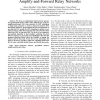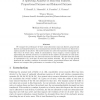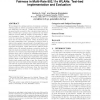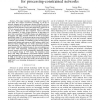104
click to vote
AAAI
2012
13 years 3 months ago
2012
We consider the classic cake cutting problem where one allocates a divisible cake to n participating agents. Among all valid divisions, fairness and efficiency (a.k.a. social wel...
118
click to vote
GLOBECOM
2010
IEEE
14 years 11 months ago
2010
IEEE
Abstract--We devise an optimization framework for generalized proportional fairness (GPF) under different time scales for amplify-and-forward (AF) relay networks. In GPF scheduling...
116
Voted
QUESTA
2006
15 years 28 days ago
2006
We compare the performance of three usual allocations (max-min fairness, proportional fairness and balanced fairness) in a communication network whose resources are shared by a ra...
112
click to vote
AAIM
2008
Springer
15 years 3 months ago
2008
Springer
We give a randomized protocol for the classic cake cutting problem that guarantees approximate proportional fairness, and with high probability uses a linear number of cuts.
117
click to vote
MOBICOM
2006
ACM
15 years 7 months ago
2006
ACM
We investigate the optimal selection of minimum contention window values to achieve proportional fairness in a multirate IEEE 802.11e test-bed. Unlike other approaches, the propos...
109
Voted
INFOCOM
2006
IEEE
15 years 7 months ago
2006
IEEE
— This paper examines congestion control issues for TCP flows that require in-network processing on the fly in network elements such as gateways, proxies, firewalls and even r...
105
click to vote
INFOCOM
2006
IEEE
15 years 7 months ago
2006
IEEE
—In 3G data networks, network operators would like to balance system throughput while serving users in a fair manner. This is achieved using the notion of proportional fairness. ...
111
click to vote
INFOCOM
2007
IEEE
15 years 7 months ago
2007
IEEE
— Multicast is an efficient means of transmitting the same content to multiple receivers while minimizing network resource usage. Applications that can benefit from multicast s...
109
Voted
ICC
2007
IEEE
15 years 7 months ago
2007
IEEE
—OFDM systems are the major cellular platforms for supporting ubiquitous high performance mobile applications. However, there remain a number of research challenges to be tackled...
111
Voted
WIMOB
2008
IEEE
15 years 7 months ago
2008
IEEE
—Packet scheduling at the data link layer may impact significantly the overall performance of a wireless system using multiple antennas. In this paper, we propose a novel packet ...




